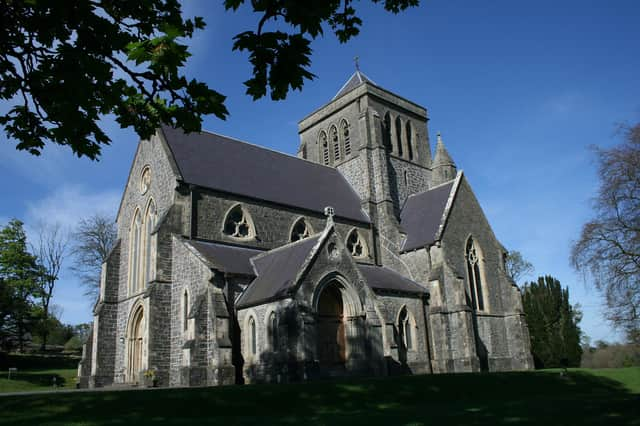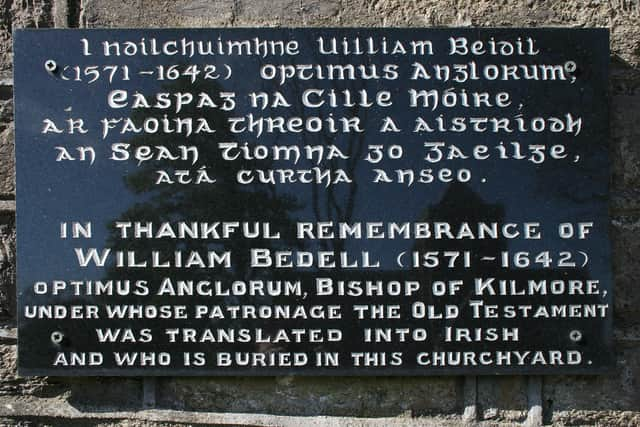William Bedell, English-born cleric who put Irish language at heart of the Church of Ireland


Few Church of Ireland cathedrals can have a more idyllic setting than St Fethlimidh’s, Kilmore.
Situated on a pleasantly wooded elevation approximately three-and-a-half miles west of Cavan town, the beauty of the neo-Gothic cathedral, built between 1858 and 1860 at the cost of £8,000 by Marcus Gervais Beresford, Bishop of Kilmore from 1854 to 1862 and Archbishop of Armagh from 1862 to 1885, is almost the equal of its surroundings.
Advertisement
Hide AdAdvertisement
Hide AdOne of the cathedral’s most interesting architectural features is the intricately carved Irish Romanesque vestry door. Originally from an early church on Trinity Island in Lough Oughter, the doorway was incorporated into the medieval cathedral – now the parochial hall – and then incorporated into the present cathedral. This doorway symbolises the Church of Ireland’s historic continuity with the early Celtic Church.


Bishop Beresford intended the cathedral to be a memorial to Mary, his first wife, and William Bedell, the diocese’s most famous bishop. At the service of consecration on June 17 1860, the cathedral was described as ‘The Bedell Memorial Church’. Over the main entrance at the west end is a tympanum, the Latin inscription on which reads as follows: ‘Gulielmi Bedelli, Quondam Kilmorensis Episcopi in memoriam’ (‘In Memory of William Bedell, one-time Bishop of Kilmore’). The inscription is derived from the epitaph penned by Bedell himself – ‘Gulielmi Bedelli, Quondam Kilmorensis Episcopi depositum’ (‘Here lies William Bedell, one-time Bishop of Kilmore’) – on his tomb.
Bedell was born in December 1571 in Essex, educated at Emmanuel College, Cambridge, and took holy orders. Initially minister at Bury St Edmunds, in 1607 he was appointed chaplain to Sir Henry Wotton, the ambassador to Venice, who memorably defined an ambassador as ‘an honest man who is sent to lie abroad for the good of his country’.
A skilled linguist familiar with both Biblical and classical languages, Bedell translated ‘The Book of Common Prayer’ into Italian while he was in Venice.
Advertisement
Hide AdAdvertisement
Hide AdA formidable scholar, Bedell’s wide-ranging interests extended to the early church fathers, the Greek Orthodox tradition and the challenges posed by Biblical translation.
In 1627, at the suggestion of Archbishop Ussher of Armagh, Bedell was appointed the fifth Provost of Trinity College, Dublin, which had been founded by Elizabeth I in 1592 (in part) to train new clergy to underpin the Reformation. In 1602 William O’Donnell, a Fellow of the College from Kilkenny, had produced ‘Tiomna nuadh ar dTigearna agus ar Slánaighteora’ (‘The New Testament of our Lord and our Saviour’).
However, dissatisfied with the college’s shortcomings, in 1620 James I (and VI) demanded that ‘young men already fitted with the knowledge of the Irish tongue be placed in the university, and maintained there for two or three years till they have learned the grounds of religion, and be able to catechize the simple natives, and deliver unto them so much as themselves have learned’.
As Provost, Bedell took Trinity’s mission very much to heart. He learned Irish and required divinity students of Irish birth to study the language so that they would be equipped to minister to their flocks.
Advertisement
Hide AdAdvertisement
Hide AdTwo years later Bedell was appointed Bishop of Kildare and Ardagh. The present diocese of Kilmore covers most of Co Cavan, north Leitrim and small areas of Fermanagh, Longford and Donegal. Ardagh extends over most of Co Longford, south Leitrim and a small area of Westmeath.
In 1633 he resigned the latter bishopric because of his strident opposition to non-residence and pluralities.
He deliberately sought Irish-speaking incumbents for every clerical vacancy and was highly critical of the failure of many Church of Ireland clergy to regard the native Irish as part of their charge. He employed Murtagh King (the Rector of Templeport) and James Nangle to assist him to translate the Old Testament into Irish.
Bedell started a daily service in Irish in his cathedral, drew up a catechism with parallel English and Irish texts (published as ‘The ABC or the institution of a Christian’ in 1631), and wrote a series of brief explanations of the main doctrines of the church in Irish. He made strenuous efforts to ensure that his clergy did not restrict their ministry to those who were already English-speaking and Protestant.
Advertisement
Hide AdAdvertisement
Hide AdDuring and after the 1641 rebellion Bedell harboured refugees from the Irish Confederates but was himself captured by the insurgents. Initially, he was well treated by his captors but he was then imprisoned in Loughoughter castle where his health suffered. Early in 1642 he was allowed to stay with the Rev Dennis Sheridan, one of his clergy, at Dromlor. There he died, aged 71, on February 7 1642. His final words were: ‘Whether we live or die we are the Lord’s.’
Bedell’s Irish neighbours regarded him as ‘optimus Anglorum’ (‘the best of the English’ in Latin). His funeral provides further striking evidence of the high esteem in which he was held.
Dr MacSuibhne, the Roman Catholic bishop, now in control in the aftermath of the 1641 rebellion, sought to deny Bedell burial in the grounds of the cathedral. Nevertheless, a fearfully defiant funeral procession bore Bedell’s body to the graveyard. Before reaching it, the procession encountered a party of insurgents. Bedell’s biographer son recalled that the insurgents, ‘commanding their drum to beat, as the manner is when a soldier is buried, and placing the musketeers before the corpse, conveyed the bishop to his grave. And being come thither, the sheriff told the bishop’s sons that they might use what prayers or what form of burial they pleased; none should interrupt them. And when all was done, he commanded the musketeers to fire a volley of shots, and so the company departed.’
Thus Bedell was buried where he himself had wished, alongside his wife Leah, in a grave underneath a giant sycamore tree, which he himself had planted.
Advertisement
Hide AdAdvertisement
Hide AdRobert Boyle (1627-91), the eminent scientist, the author of Boyle’s Law and a deeply religious man, paid for the printing and publication of ‘Leabhuir na Sein-Tiomna’ (the Old Testament in Irish) in London in 1685.